Cnidaria Study guides, Class notes & Summaries
Looking for the best study guides, study notes and summaries about Cnidaria? On this page you'll find 205 study documents about Cnidaria.
Page 3 out of 205 results
Sort by
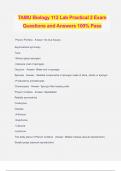
-
TAMU Biology 112 Lab Practical 2 Exam Questions and Answers 100% Pass
- Exam (elaborations) • 23 pages • 2024
- Available in package deal
-
- $13.49
- + learn more
TAMU Biology 112 Lab Practical 2 Exam Questions and Answers 100% Pass Phylum Porifera - Answer- No true tissues Asymmetrical symmetry Taxa: -Silicea (glass sponges) -Calcarea (rest of sponges) Osculum - Answer- Water exit in sponges Spicules - Answer- -Skeletal components of sponges made of silica, calcite or spongin -Produced by amoebocytes Choanocytes - Answer- Spong's filter-feeding cells Phylum Cnidaria - Answer- Diploblastic Radially symmetrical Cnidocytes Classes: -Anthozoa...
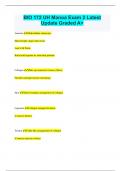
-
BIO 172 UH Manoa Exam 2 Latest Update Graded A+
- Exam (elaborations) • 26 pages • 2024
- Available in package deal
-
- $9.99
- + learn more
BIO 172 UH Manoa Exam 2 Latest Update Graded A+ Animals Multicellular eukaryotes Heterotrophs: Ingest their food Lack Cell Walls Body held together by structural proteins Collagen Make up connective tissues (fibers) Flexible and high tensile (stretching) Skin Dense irregular arrangement of collagen Ligament Collagen arranged in sheets (Connects Bones) Tendon Cable-like arrangement of collagen (Connects muscle to bone) Zygote Fertilized egg (Sperm+Egg=Zygote) Undergoe...
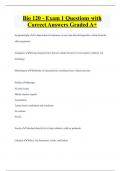
-
Bio 120 - Exam 1 Questions with Correct Answers Graded A+
- Exam (elaborations) • 39 pages • 2024
- Available in package deal
-
- $12.99
- + learn more
Bio 120 - Exam 1 Questions with Correct Answers Graded A+ Synapomorphy A shared derived character or trait state that distinguishes a clade from the other organisms. Analagous Having characteristics that are similar because of convergent evolution, not homology. Homologous Similarity in characteristics resulting from a shared ancestry. Porifera Sponges No true tissues Mostly marine, aquatic Asymmetric 2 germ layers (endoderm and ectoderm) No coelom Sessile Sessile Attached direc...
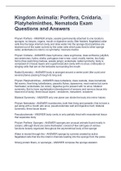
-
Kingdom Animalia: Porifera, Cnidaria, Platyhelminthes, Nematoda Exam Questions and Answers
- Exam (elaborations) • 3 pages • 2022
-
- $9.99
- + learn more
Phylum Porifera - ANSWER simple, sessile (permanently attached to one location) sponges; no tissues, organs, mouth or digestive cavity; filter feeders: flagellated collar cells line the large internal cavity and draw water into the sponge (food particles are strained out of the water current by the collar cells which pass food to other sponge cells); acolemate (no colon); no symmetry; most are marine Phylum Cnidaria - ANSWER class hydrozoa, class scyphozoa, class anthozoa; jellyfish, sea anem...
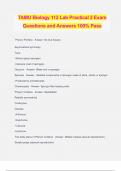
-
TAMU Biology 112 Lab Practical 2 Exam Questions and Answers 100% Pass
- Exam (elaborations) • 23 pages • 2024
- Available in package deal
-
- $12.49
- + learn more
TAMU Biology 112 Lab Practical 2 Exam Questions and Answers 100% Pass Phylum Porifera - Answer- No true tissues Asymmetrical symmetry Taxa: -Silicea (glass sponges) -Calcarea (rest of sponges) Osculum - Answer- Water exit in sponges Spicules - Answer- -Skeletal components of sponges made of silica, calcite or spongin -Produced by amoebocytes Choanocytes - Answer- Spong's filter-feeding cells Phylum Cnidaria - Answer- Diploblastic Radially symmetrical Cnidocytes Classes: -Anthozoa...
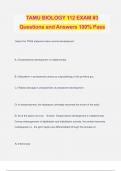
-
TAMU BIOLOGY 112 EXAM #3 Questions and Answers 100% Pass
- Exam (elaborations) • 33 pages • 2024
- Available in package deal
-
- $13.49
- + learn more
TAMU BIOLOGY 112 EXAM #3 Questions and Answers 100% Pass Select the TRUE statement about animal development: A.) Deuterostome development is indeterminate. B.) Mesoderm in protostomes arises as outpocketings of the primitive gut. C.) Radial cleavage is characteristic of protostome development. D) In deuterostomes, the blastopore ultimately becomes the mouth of the adult. E) All of the above are true. - Answer- Deuterostome development is indeterminate. During embryogenesis of diploblasti...
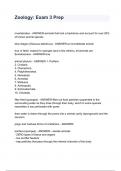
-
Zoology: Exam 3 Prep questions and answers
- Exam (elaborations) • 15 pages • 2024
-
- $7.99
- + learn more
invertebrates - ANSWER-animals that lack a backbone and account for over 95% of known animal species blue dragon (Glaucus atlanticus) - ANSWER-an invertebrate animal true or false: expect for sponges (and a few others), all animals are Eumetazoans - ANSWER-true animal phylum - ANSWER-1. Porifera 2. Cnidaria 3. Ctenophora 4. Platyhelminthes 5. Nematoda 6. Annelida 7. Mollusca 8. Arthropoda 9. Echinodermata 10. Chordata filter feed (sponges) - ANSWER-filter out food particles suspen...
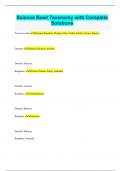
-
Science Bowl Taxonomy with Complete Solutions
- Exam (elaborations) • 4 pages • 2024
- Available in package deal
-
- $8.99
- + learn more
Science Bowl Taxonomy with Complete Solutions Taxons in order Domain, Kingdom, Phylum, Class, Order, Family, Genus, Species Domains Eukarya, Bacteria, Archaea Domain: Eukarya Kingdoms: Protista, Plantae, Fungi, Animalia Domain: Archaea Kingdom: Archaebacteria Domain: Bacteria Kingdom: Eubacteria Domain: Eukarya Kingdom: Animalia Phylum: Porifera, Cnidaria, Platyhelminthes, Nematoda, Annelida, Arthropoda, Mollusca, Echinodermata, Chordata Phylum: Species: Huma...
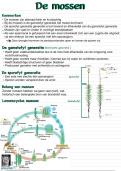
-
Evolutie en Biodiversiteit samenvatting deeltoets 2 van het plantenrijk, invertebraten en chordata.
- Summary • 13 pages • 2023
-
- $3.98
- 1x sold
- + learn more
In het document is voor elk van de volgende planten groepen in het planten rijk een samenvatting gemaakt: de mossen, de wolfsklauwachtigen de varenachtigen, de naaktzadigen, de bedektzadigen. Hierbij wordt voor elk aangegeven wat hun kenmerken zijn, hun belang, hun levenscyclus en nog uitleg over andere belangrijke eigenschappen. Hierna zijn ook de volgende fylums samengevat van het dierenrijk: de porifera, de cnidaria, de platyhelminthes, de nematoda, de mollusca, de annelida, de arthropoda, de...
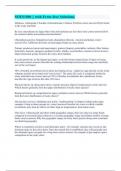
-
SOES1006 || with Error-free Solutions.
- Exam (elaborations) • 11 pages • 2024
-
- $10.99
- + learn more
Mollusca, Arthropoda, Chordata, Echinodermata, Cnidaria, Porifera correct answers Phyla found in the rocky intertidal By size: macrofauna are larger than 1mm and meifauna are less than 1mm correct answers How do scientists define macrofauna and meiofauna? Chlorophyta (green), rhodophyta (reds), phaeophyta (browns - fucoids and kelps) correct answers The 3 different divisions of macroalgae found on rocky shores Primary producers (micro and macroalgae), grazers (limpets, periwinkles, urch...

How much did you already spend on Stuvia? Imagine there are plenty more of you out there paying for study notes, but this time YOU are the seller. Ka-ching! Discover all about earning on Stuvia


